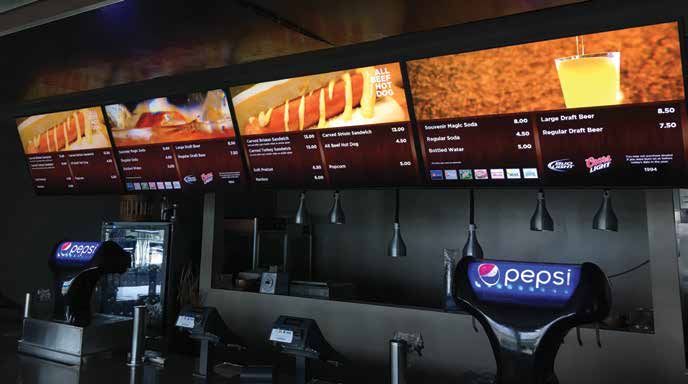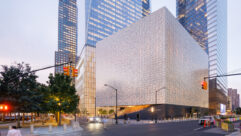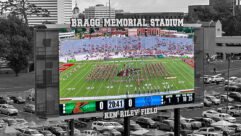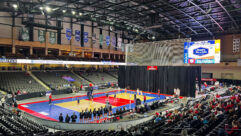

SVC: The project we’re talking about here is not your average low-profile, changing-speakers-in-a-church sort of thing. This was rolled out in front of thousands of Orlando Magic fans. Let’s be honest. Sports fans are not the most patient crowd in the world, especially after they’ve imbibed a little for the game and if something isn’t working right, they’re going to let you know pretty fast.
Curtis: This is certainly not a low-profile gig for us. Sports fans in general are looking for their content and they’re looking for it now, so this particular project was pretty monumental from the outset. The folks down at the Amway Center in Orlando had an existing Harris Infocaster system that was doing various feeds. I believe the total count was right around 900 monitors total, so there was a lot of desire from the Magic to streamline content delivery. And when I say content delivery, it wasn’t just internal content that was going out from in-house video replay systems. This was branding across the board from their in-house cable TV system, their in-house feeds, their external feeds, and rolling this all into one system with their digital signage systems including retail point-of-sale, concession stands and really any monitor in the building. We worked very closely with Vitec and with the nice folks at Four Winds Interactive to put out a system that allowed them to really have that control and to brand the facility not just for Orlando Magic games, but increase revenue with them when they had external events coming in.
So it wasn’t just new software on the old system. Your guys had a lot of grunt work to do running cable and mounting displays and everything.
Absolutely. On these types of projects we always look to what we can reuse and what needs to come out or be put in new? The nice thing about the Amway Center is from a cabling perspective, it was fairly reusable. We ended up not having to really pull cable back. They had the foresight on the original system build to get network drops to every monitor in the facility, which was something that we don’t typically see. The heavy lifting came on the front end. All of the old Harris encoders came out and we put in an entire new Vitec encoding system on the front end. That allowed us to do a couple of things. We were able to pull down the DirecTV feed they were using to re-encode and broadcast throughout the facility, but it also allowed us to seamlessly combine those internal feeds from their video replay system as well as give us the capability to bring in some Ross Xpressions that are doing some custom graphics and branding. We partnered with Vitec to drop in their Amino players—what you would think of as a set-top box. It has an IR receiver, HDMI output on it. It allows you to control signals on the local monitor with a traditional IR remote. We worked with them to set a custom channel lineup to be able to feed signals throughout the plant. They can do different zones. They can create custom channel lineups by zone. They can allow their premium suite holders access to content, whether it’s NBA league pass or other premium content that they wouldn’t normally want to make available to the general public in the facility. So they can set these groups up and we can do custom channel lineups with custom branding on it. If you have a particular suite that’s sponsored by a corporate sponsor, we can extend their branding now to the actual overlay of the graphics on that monitor. So there’s really a lot of power in the system that’s afforded to us with the Vitec head-end.

There seem to be a lot of capabilities that the fans are accustomed to seeing at home but not used to seeing in a venue.
Using the Aminos as the set-top boxes is very similar to your home experience. People walk in, they want to press the menu button and they want to be able to scroll through a channel list. They don’t want to have to do the older-style channel selection by just pressing channel up and down. The other part of this that’s interesting is the Orlando Magic and Dave Storm and his crew, and their coordination and collaboration with Four Winds Interactive. Four Winds Interactive provided a stand-alone computing platform to support direct applications for digital signage. So in areas where we have point-of-sale, or concessions, each monitor had its own computer player mounted behind it. The nice thing about these little boxes is they can tap directly into the Vitec IP streams that are available on the Amino boxes we talked about. So we can bring those monitors up, we can give them a live video feed, but we can also set timers and players to play various different clips at predetermined times. They can change graphics out. Where this is powerful for the Magic and the Amway Center is really in the concessions area. They can have their concession boards up with pricing, but beyond that we have fans that don’t want to be away from the game. So it affords the Amway Center staff the capability to do some squeeze backs if they want to do live video as part of the overlay, they can make custom L bars and different things. The system can also fire moments of exclusivity from the production environment, so when there’s a big play on the court, someone comes up and has a huge three-pointer, they want to extend branding to the LED video boards, they can also extend that branding to the monitors and TVs throughout the facility. It’s one integrated stream. It allows production staff, with one or two clicks of buttons now, to brand the entire facility across the board and that’s a very, very powerful thing. The dynamic element is very big for them as well. A lot of the Four Winds components can pull stats feeds so we can set up stat servers and get real-time score updates not just from the in-house games, but we can have that pull from games outside the facility as well. All of this ties back to what it does for fan interaction. Fans are accustomed to their content and they’re accustomed to it now. They’re also accustomed to creating their own content via Twitter, Tumblr, Instagram, all these various social media feeds. So now the Amway Center staff can set up specific zones that have certain monitors that are listening for specific keywords and certain hashtags that are out there, and we can set this up where someone can review tweets and different posts before they go live. We can bring an interactive element into a lot of different areas of the system that wasn’t available to them before. And by having this kind of hybrid system between the Four Winds boxes and the Aminos from Vitec, and having a Vitec head-end to drive it all, it makes it one platform for everybody to work with and really have a seamless presentation to the end user.
Those set top boxes, that’s a lot of machinery to have scattered out over a very large arena. Obviously, one of the things you’re concerned with there is in lowering the failure rate of those things and improving the playback capability so what did you do about that?
The first thing that really makes this manageable on the Vitec side is the EZ TV management software. We spent significant time going through and mapping every monitor in the facility and which IP address is being assigned to those locations. We also remember the old adage: if it ain’t broke, don’t fix it. The Amway Center had an existing numbering sequence that they’re familiar with not just from a technical operations side, their staff is familiar with using it on the usher side as well. So if an usher is escorting someone to their seat and they notice that a monitor is out, that usher can call back to his representatives and they can relay that technical information directly to the control room. The control room staff can then use the EZ TV software to diagnose whether it’s a receiver that’s lost its stream or if the TV just needs to be reset, or in some cases the TV’s just been turned off and needs to be turned back on remotely. If it’s something beyond that, they can dispatch a technician. Having the software in place to manage those things really cuts down on the manpower resources required. A very large percentage of the failure is simply because someone has turned the TV off. And oftentimes within a few seconds we can get back to that usher and ask if the TV came back on or not before we actually have to send someone out to look at it. In addition to that, there’s the support and warranty coverage that’s available from Vitec. We, of course, always plan for failures. We’ve always got spares. The physical connections on the Amino settop boxes make them very easy to swap out. We’re generally looking at a network connection, an HDMI connection, and in some cases an IR connection.

And this represents a substantial investment even for a pro sports team so it has to be fairly well future-proofed also.
The compression mechanisms that are available to us today are only going to continue to get better. We worked really, really closely with the in-house IT department to ensure that we were doing the appropriate multicast streams and it wouldn’t be interfering with other network operations. We made sure that all of our HDMI devices were 1.4 compliant. We want to give them as much future-proofing available as possible.
So what was the most challenging part of this, was it the timeframe of getting all of this done?
You always need more time and you always need a little more money to make it not quite as challenging. Really the most challenging part of the project was worrying about all the things that could go wrong up front and making sure that we had all of the parties involved from a networking standpoint. The Amway Center is unique in that they have an internal IT department in the building. With many of these things it’s getting the IT department to understand, because they hear video streams, they hear high-definition video on their network, and they immediately become very concerned about bandwidth – and for obvious reasons. And really the way the Vitec system manages the multicast streams is very efficient on network resources. The most challenging part was sitting down and educating all of the users in the facility that we’re going to be members of this; really educating the key stakeholders as to what this technology was allowing the facility to do and how it would be doing those things. And once we got everybody on board to this, everybody bought in fairly quickly and we moved forward at a pretty rapid pace. That led to the second challenge, which was how do you deploy unique content to 600-plus monitors? We’ve got 900 monitors in the facility total, but 600 of them had unique content at any given time. So the internal graphics team was really pushed to come up with unique branding and unique content on all of these monitors. It’s fun for us as integrators to be able to give our end users the tools that challenge them to put out quality product.

And you have to control all of these things and give the fans just the right amount of control at their end, so how did you manage to control all of the set-top boxes? Was that through IR links or serial connections, network lines, or who can do what from where?
We’ve got a couple of different options here. So the primary function where we’re giving the users control is in the premium suites seating areas. There are a number of suites that have the Amino set-top boxes that, again, function like your traditional set-top box at home. The Amino boxes are mounted behind the TVs. Then we went in with the traditional provided IR remotes. We did some basic testing. In a couple of cases we needed to do some basic IR extension on those particular units, but for the most part the Aminos are pretty flexible in terms of their IR reception. In some other spaces, where we’ve got more of an AV component going on, a lot of the Aminos just operate purely as a set-top box controlled via an IR extension on a Crestron system. We had to go through and do a fair amount of upgrade to existing Crestron control code to make sure that we had control of the Amino set-top boxes correctly. But once we got that in place, it was pretty easy to copy and paste that information throughout the facility. It’s probably a 2-to-1 mix between boxes that have the Four Winds interactive players on them and the Amino set-top boxes. In those cases, almost every monitor is hooked back to one of those two devices with a serial cable. That gives us capability to do power on/off commands. We can do input resets to monitors to make sure that we’re on the appropriate inputs. But when “We partnered with Vitec to drop in their Amino players — what you would think of as a set-top box. It has an IR receiver, HDMI output on it. It allows you to control signals on the local monitor with a traditional IR remote. the shipment came in it was a whole lot of settop boxes and Four Winds players, and it was a whole lot of serial cable getting hooked up. I will say that Vitec was very adamant about the Amway Center sending off a monitor or two. The testing that went into this ahead of the deployment was pretty extensive. I’m sure everybody can relate to the fact that with the sheer number of monitors we were going to be dealing with, we didn’t want to be in a situation where we swapped everything out and went to go test and it didn’t work.
The Orlando Magic’s IT department had to cooperate very closely on this.
There was a lot of preplanning on the IT side-capturing IP addresses and MAC addresses and spreadsheets and reconciling spreadsheets and shipping labels and all that. Working with Vitec, they really made it very easy. Don’t take it for granted when you get a box with a piece of equipment in it that’s already got a serial number and a MAC address because that was really a pretty big key to all of this.

And then at some point along the way, handing off pieces of that to the local people, then turning them loose on it and seeing what they can do.
And Dave Storm and his crew down there are top notch when it comes to the technical side. They picked it up very, very quickly and really have taken ownership of it. That’s always good to see with a client, that they can make it their own at the end of the day.
And of course one of the most satisfying things has got to be just watching the fans come in and enjoy the new system and all of the oohs and ahs and pointing at the monitors.
It is, you know, very stunning to see in a facility of this size. CTG is fortunate to work with a tremendous number of venues throughout the United States, but I have to say that by far the Amway Center has some of the best internal branding of any facility in the U.S. And really the Vitec system running in combination with the Four Winds players and the Amino set-top boxes allows them to deliver creative content in ways that we are just starting to scratch the surface of.









